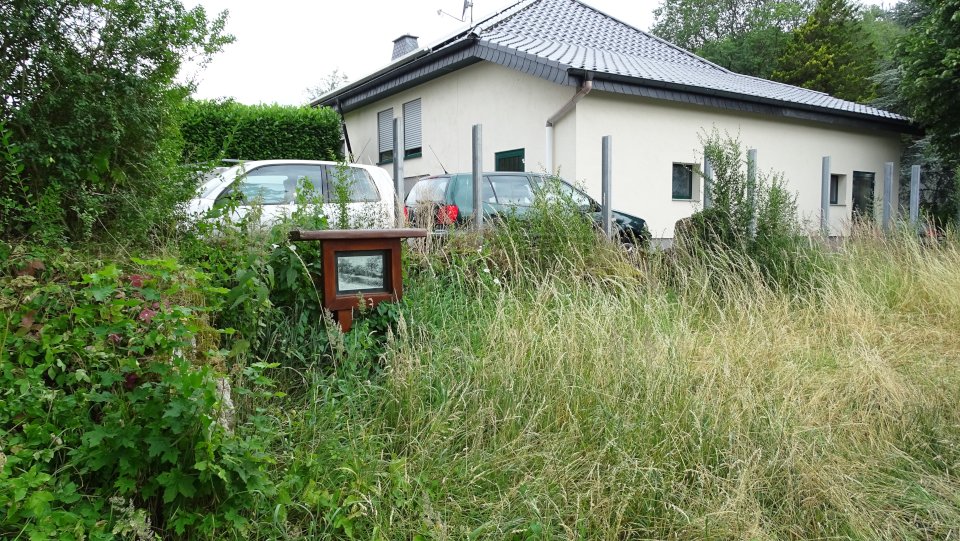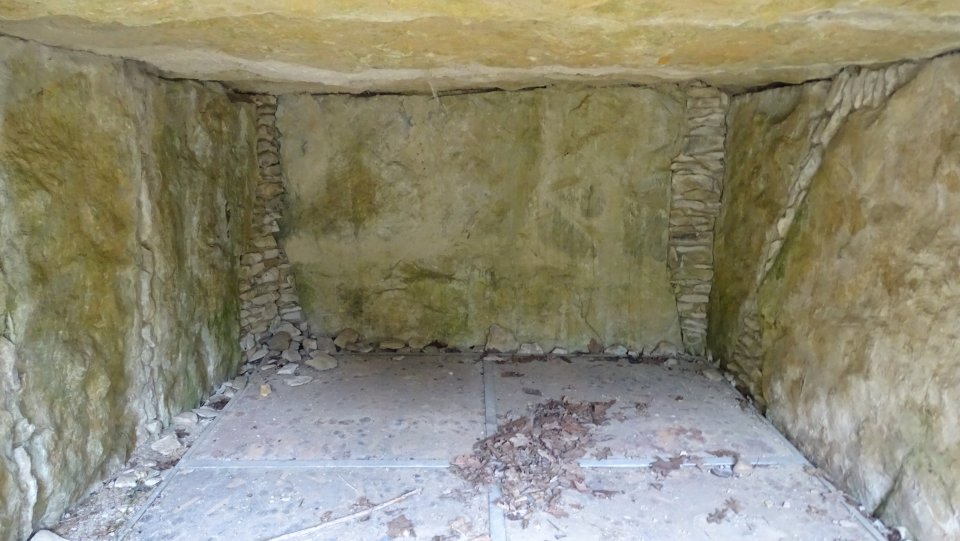
Trust me it is there....
Visited July 2018

Trust me it is there....
Visited July 2018



The gallery grave Atteln I lies today on the edge of a small industrial area Auf dem Hohenloh east of Atteln and north of the road L754 to Husen. After leaving the Attelner Straße (L754) follow the road Im Mersch for about 175m and you’ll find the tomb in a small clearing surrounded by trees to you right.
The tomb is oriented in northwest-southeast direction. It is about 21m long and 2.5-3m wide. The entrance was on the eastern narrow side and was closed by a simple drywall of river boulders, some stones of the drywall are still present. For the reconstruction of the tomb 17 original stones were used, missing stones were replaced by limestone blocks from a nearby quarry. The original height of the chamber could be reconstructed by a completely preserved wall stone at 1.65 meters. The northwestern end of the chamber, which is not accessible, was reconstructed using this stone.
Visited July 2018





Don’t know if these stones belong to the actual tomb or not
Visited July 2018

Leaflets in German and English (PDF)





The relief of the Descent from the Cross
Visited August 2014

Open tombstone in an arched niche
Visited August 2014

Upper cell with altar niche
Visited August 2014

The gallery grave of Rimbeck – Warburg lies northeast of the village Rimbeck and belongs to the Hessian-Westphalian galleries. To reach the site leave the B7 into Elisabethstrasse, after about 430m when the road bends to left continue straight ahead into Zur Märk. After about 250m there is a slight right bend and you are in the road Zum Weissen Holz. Continue on this road for about 500m until you reach the forest. Park here and use the middle forest track which goes uphill for about 450m, where a little beaten path leaves the main track to the left. You should notice the information board of the tomb from here.
The 12 m long and 2 m wide gallery grave is embedded in the ground. While the supporting stones are largely preserved, no capstones were found. The site originally consisted of a chambered tomb completely covered with stone slabs, which lay under a mound and only connected to the outside world by a short corridor with a Port-hole slab (German: Seelenloch) still visible today.
The large pieces of rock from sandstone, which served as the building material, do not occur at the site. They had to be brought over a distance of 3.5km.
Visited July 2018






A close look at the lateral entrance
Visited July 2018

The menhir of Hertingshausen is located on the edge of a small wood, north of the K22 between Baunatal and Hertingshausen. It is a strangely wedged shaped 2m high stone that looks like much of it has broken away and is now missing.
Like the Hünstein – Großenritte in Baunatal this menhir consists of quartzite, which was probably broken from the Hertingshäuser cliffs.
Visited July 2018
The Hünstein of Großenritte is now located at the Hünsteinplatz in the midst of a relatively new residential estate in Baunatal in the district of Großenritte. It is 2,75m high and weights about four tons.
It consists of a quartzite that is not present here. A material analysis showed that the Hünstein was probably broken from the Hertingshäuser cliffs, which are about 3.8km away.
Visited July 2018







The gallery grave Lautariusgrab (Gudensberg) lies about 500m southeast of the L3218 road between Metze and Edermünde. There is a car park (Gestecke) where a forest track to the tomb starts.
The tomb has a rectangular layout of 10m long and 5m wide, it is assumed that the tomb was not covered with stones, but with wood.
Visited July 2018
Taken from one of the (red) information board:
The Lautariusgrab is a prehistoric cultural monument from the Neolithic Wartberg culture in the Gudensberger city forest. The origin of the name is unclear.
The prehistoric site consists of an above-ground burial chamber with two open antechambers. The tomb is unique in northern Hesse because of its shape and the purely aboveground construction. Other plants of the Wartberg culture are the gallery tombs of Züschen and Calden, which were partially sunk into a slight slope or covered with a mound. The tomb has a rectangular layout with a length of 10 m and a width of 5 m. It was probably covered with wood. The processed stones are made of quartzite and basalt. The floor of the grave was paved.
Settlements of the Wartberg culture are less than a kilometer away on the Gudensberger Bürgel and Güntersberg.
In 1932 the tomb was first uncovered and examined. Only a few skeletal remains in the form of bone fragments, a few fragments of cups and two stone ax made of siliceous rock were found. This small number of finds is explained by the above-ground construction and the rapid decay after ritual use. It makes dating difficult, but it can be assumed that the grave dates from around 3500-3000 BC. Chr. The finds are today kept in the Hessian State Museum in Kassel.







Züschen I, classified as a gallery grave or a Hessian-Westphalian stone cist, lies east of Züschen and north of the road L3218 to Lohne. There is a small car park about 100m south of the tomb. According to Wikipedia the German term of gallery grave for a certain type of megalithic sites is derived from the French term Allée couverte.
The rectangular chamber is 20m long and 3.5m wide. It is built of rectangular sandstone slabs, which can’t be found on this valley side of the Elbebach. Each long wall consists of a row of 12 slabs, one of which is missing. The narrow walls consist of a single slab each. Some of the stones (b1 and b2) contain some incised carvings, comparable to prehistoric rock art elsewhere in Europe.
Due to increasing vandalism, like the engraving of names and signs, the tomb was roofed and fenced in 1986. According to the display panel, it is still possible to visit the tomb from inside, a key can be obtained from the museum in Fritzlar located in the Hochzeithaus (wedding house).
Visited July 2018

